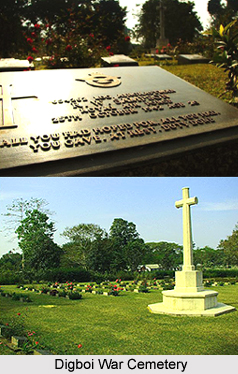 Digboi War Cemetery is situated outside the oil town, Digboi Oil Town, some 1.5 kilometres from the main India Oil (Assam) Works on the road to Pengaree Tea Estate.
Digboi War Cemetery is situated outside the oil town, Digboi Oil Town, some 1.5 kilometres from the main India Oil (Assam) Works on the road to Pengaree Tea Estate.
Digboi town is located in the northeastern corner of Assam. In this place lie the remnants of the most dramatic event that took place in the history of India, during the Second World War. The Second World War started in September 1939 and became a global military conflict, involving a majority of the countries in the world - Axis Powers and the Allied Powers. Approximately sixty million people died because of the war, twenty million of which were soldiers and the rest were civilians.
During the Second World War, Assam served as an operational area of the Burmese campaign.(Operation to fight with the Japanese Force and Indian National Army led by the most influential and popular Indian Freedom Fighter, Supreme Commander in Chief Netaji Subahas Chandra Bose). Digboi, situated near the Burmese border, was on the lines of communication and a military hospital was established in the area, for treating the war casualties. Digboi War Cemetery was initially started for the burials of the Anglo American military personnel from the hospital. By the end of the war, a total of 70 burials had been recorded. Later, Army graves were also transported from the graveyards in Panitola, Jorhat, Ledo, Margherita and Tinsukia District, to Digboi War Cemetery.
The maintenance of graveyards in Panitola and other areas was becoming a major problem, so the graves were transferred to Digboi. Graves were also transported from the US Military Cemetery at Shingvuoiyang, Myanmar. As a result, a large collection of corpse accumulated on the small spur of land rising from the main road, near the hospital. However, due to the earthquake in 1950 and the subsequent landslides caused by heavy rains, it became necessary to shift the cemetery to a place, which would not be affected by erosion. The cemetery was hence shifted to the present site i.e. 1.5 km from the Indian Oil Centre. Digboi Cemetery of World War-II is of the Europeans (mainly British) deployed in this Front for joint Operation with the Chinese and the Americans under General Stil Well. Some British Officers of OIL who might have died were also perhaps laid here, may be due to lack of adequate facilities to send the bodies back home. However, the bodies of the Americans and Negros were temporarily buried on a plot of high land retrieved in coffins and carried back to their homeland. After the Second World War was over, the Chinese government used to send some grants once a year for the maintenance of this Cemetery. The grants were sent to the then Political Officer at Margherita in charge of the erstwhile Tirap Frontier Tract till the Communities of North China overthrew Chiang Kai Shek`s government.
Looking at the thousands of burials over this vast expanse of land, one can imagine the horror of the war that took place about 70 years ago. A sense of worship and respect automatically comes to the heart of the people when they come to pay obeisance to the war heroes at the cemetery. The cemetery now has around 200 burials of the Second World War. This cemetery is a historical place where thousands of brave soldiers of Allied Powers are resting in peace. The relatives of heroes of World War-II came to visit from Margherita, Ledo and Lekhapani area to the Digboi War Cemetery to pay the homage. On every second Saturday of November, a prayer ceremony is held to remember the brave souls and verses from Holy texts, like Holy Bible, Gurugranth Sahib, Bhagavad Gita and Koran, are read. A visit to this place is essential to pay homage to the valiant people who lost their life during World War II.



















